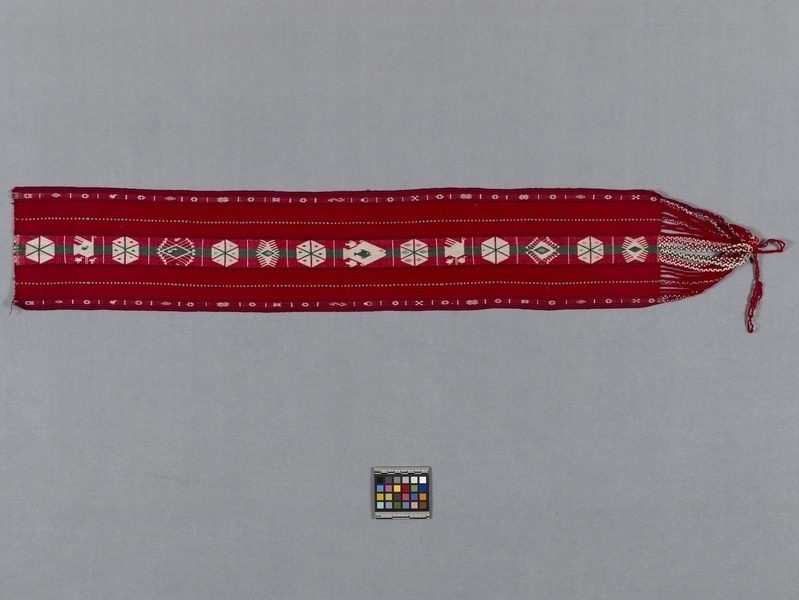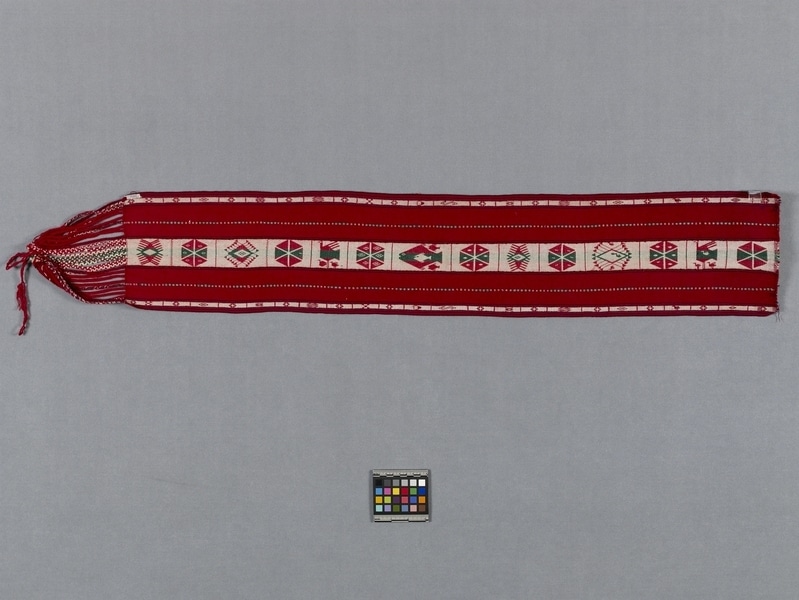Belt Item Number: Sf909 from the MOA: University of British Columbia


Description
Belt with a large central patterned band, smaller lateral bands, blue and green lines flanking each lateral band, and a red, green and white band with squares that flanks the centre band and green. One end is fringed with braided threads tied together with a re-plied cord. The central band contains bird, fish and geometric motifs, and the lateral bands contain geometric motifs. The remainder of the belt is red.
History Of Use
Warp-faced fabrics with three or four selvedges are woven by women but the fabrics, the techniques, the structures, and some of the motifs have pre-Conquest antecedents. This type of textile conveys the most information about an individual's ethnicity, sex, age, status, and particular history. Used in the Sikuri dance, by both sexes, performed June 24, El Dia de Campesino, during the community fair, July 25 - Aug. 5, and on some Catholic holidays. The Sikuri dancers wear braided wigs, feathered hats, and play the pan-pipes while doing very structured, traditional dances.
Iconographic Meaning
The range of motifs refers to local geography and landmarks, ecology, fecundity as well as luck. The six part circle refers to the division of land into six sections on Taquile and the rotation of crops and fallow periods.
Cultural Context
Sikuri dance.
Specific Techniques
Weave structures are the following: 1-plain colour areas are warp faced plain weave. 2- figurative designs; complementary-warp weave with 3-span floats aligned in alternate pairs with an irregular (abbabaab) warping order (3/1 horizontal colour changes and diagonals of 2-span floats). 3- stripe with squares; float weave derived from turned 2/1 horizontal herringbone with floats forming squares.
Item History
- Made by Pelagia Quispe de Yucra (Maker) in Taquile, Puno, Peru during 1980
- Collected by Mary Frame during 1985
- Owned by Mary Frame before May 8, 1986
- Received from Mary Frame (Seller) and Museum of Anthropology Shop Volunteers (Funding source) on May 8, 1986
What
- Name
- Belt
- Identification Number
- Sf909
- Type of Item
- belt
- Material
- synthetic fibre, wool fibre and dye
- Manufacturing Technique
- respun, woven, spun and braided
- Overall
- height 17.5 cm, width 110.0 cm
Who
- Culture
- Quechua
- Creator
- Pelagia Quispe de Yucra (Maker)
- Field Collector
- Mary Frame
- Previous Owner
- Mary Frame
- Received from
- Mary Frame (Seller) and Museum of Anthropology Shop Volunteers (Funding source)
Where
- Holding Institution
- MOA: University of British Columbia
- Made in
- Taquile, Puno, Peru
When
- Creation Date
- during 1980
- Collection Date
- during 1985
- Ownership Date
- before May 8, 1986
- Acquisition Date
- on May 8, 1986
Other
- Item Classes
- textiles
- Condition
- good
- Accession Number
- 1131/0002